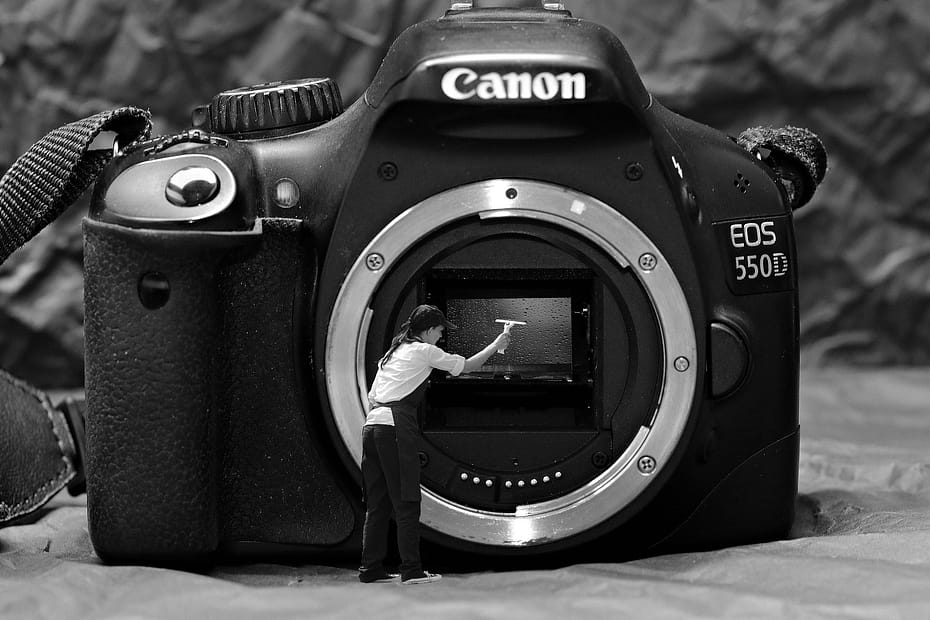So, you were looking for an easy-to-understand guide about camera sensor types, and suddenly you found yourself reading this article.
Perfect! You’re in the right place because it’s true:
“One issue that often scares newbies in photography due to its apparent complexity is the issue of photosensors in digital cameras.”
Don’t worry! We’re here to spread photographic knowledge and democratize photography among all of our readers.
So, stop feeling scared; camera sensor types or anything related to camera sensors is not a complicated issue at all.
It turns out that the sensor is a complex piece in any camera so, I’m going to talk about this “vital organ” named “sensor” in simple words.
So, if you’re about to buy your next camera, you’ll be well informed about what a sensor is, so you can make the right choice.
Let’s go!
What is a sensor in a digital camera
It doesn’t matter if it’s one type or another; the sensor is the heart of our camera:
“Everything we do to capture a good photo, from the moment we frame to the moment we shoot, are actions that pursue a single purpose: to direct the external light towards the camera sensor to capture an image.”
As the name implies, the sensor is a “sensitive” element in the camera where light is projected. It captures and draws an image that represents what our camera sees.
The sensor is to digital cameras like the film or reel was to analog cameras. The difference is that in analog cameras, the film had to be changed frequently. In contrast, in digital cameras, there is no need to change the sensor unless it’s faulty.
We can “project” on it as many digital photos as we want since we already have the memory card to store our images.
How does a sensor work?
Please don’t be like my little nephew when he’s curious about something; don’t break your camera! Let me explain how the sensor works 😉
Your camera’s sensor is a kind of small chip made up of millions of light-sensitive “points” or silicon semiconductors – they conduct electricity.
These points always have to be in the dark, and as soon as they’re exposed to light (photons), they capture it. They operate by transforming light into electricity and measuring the intensity of that electric current. These values are later transformed into digital values named pixels.
The sensor results (already translated into digital format) are saved on memory cards as image files – you know, those that end with “.jpeg, “.png” and so on.
The sensor acts like a roll of film in digital photography.
Types of technology used in sensors
Sensors can be classified according to their technology, and the one in your camera probably belongs to any of the following types.
- CCD and Super CCD
- CCD RGBE
- CMOS
- Foveon X3
- LiveMOS
However, in reality, the two most popular camera sensor types are the CCD and the CMOS.
I won’t delve into too many technical specifications here; what you should know is that CCD sensors were the first to be used, but nowadays, most cameras are using CMOS sensors…
Well, it was discovered that this new technology named CMOS allowed the creation of sensors with less power consumption and, at the same time, faster image processing.
On the other hand, it’s cheaper for factories to make a CMOS than a CCD sensor.
In terms of image quality, in the past, CCD technology offered better image quality. Still, CMOS, over time, has achieved that quality.
Foveon X3 is a technology based on CMOS, but these sensors are mainly used in Sigma’s compact cameras and digital single-lens reflex cameras (DSLR).
Finally, LiveMOS technology is used in the Four Thirds and Micro Four Thirds range of cameras. LiveMOS gives the same image quality of CCD, but with less power consumption.
We’ll focus mainly on CCD and CMOS sensor types.

What are the different sizes of sensors?
Here is a list of the most common sensor sizes, from the largest to the smallest.
Only remember this: usually, “the bigger the sensor, the better.”
But there are also a couple of things you still need to know – more on that later.
Full Frame sensor: also known as 35mm sensor. Dimensions: 36 x 24mm
In photography, these sensors are mostly used in professional cameras.
It’s the largest sensor, and it has a greater number of photosensitive cells, so they can capture more information about the scene.
When we think about Full Frame sensors, the first thing we imagine are large and heavy cameras; however, it’s not that way.
The new manufacturing techniques used by Sony and Nikon have significantly reduced the size of cameras. This avoids one of the great drawbacks of purchasing a camera with a Full Frame sensor.
APS-H sensor: Dimensions: 28.1 x 18.7mm
This type of sensor was initially used in Canon’s 1D series of cameras. These were useful for shooting sport and wildlife scenes, but this sensor size has been discontinued. I’ve included it here only for informative purposes.
APS-C sensor (used in Nikon, Pentax, Sony and Canon). Dimensions: varies.
The APS-C sensor is what’s used in most standard cameras in the market. Its manufacture is quick and less expensive, which lowers its price considerably.
It’s sized at 22.2 x 14.8mm in Canon cameras, while in Sony, Nikon, and Pentax cameras, it’s sized at 23.6 x 15.7mm.
The fact that it has a smaller number of cells doesn’t prevent this sensor from achieving spectacular results. But it affects the focal length of the lenses that we need to add to our equipment.
For example, when we work with an APS-C sensor and an 18-55mm standard focal length lens – the lens that is usually included in camera kits – the actual focal length won’t be 18mm, it’ll be about 27mm; it’ll be increased.
So, if you are working with a telephoto lens, its distance will be increased, and you’ll get close-ups of scenes far from you.
This can be really useful when you want to work with astrophotography or birds and wildlife photography, for example.
Foveon sensor (used in Sigma cameras). Dimensions: 20.7 x 13.8mm
The architecture of this sensor is based on three layers of silicon located one below the other.
The main advantage of this type of sensor is the resolution and sharpness obtained; this is because it has larger useful surface compared to other sensors.
This allows for a wider dynamic range and chromatic richness. However, there are complaints of excessive noise with long exposures. This could be an isolated problem with the sensor as there are people saying the opposite.
Micro Four Third Sensor: Dimensions: 17.3 x 13mm
These sensors are about a quarter of the size of a Full Frame sensor. They can double the effective focal length of a mounted lens.
They are usually used in Olympus and Panasonic cameras. They’ve become very popular in premium compact cameras and other pocket devices.
Sensor size and its impact on photography
One of the most common questions in photography is:
Is the size of the camera sensor important?
The answer is yes, but bear in mind that as we mentioned before, the saying:“The bigger the sensor, the better”, is not always right.
Consider the following factors:
Camera sensor size and image quality
Differences in the size of the camera sensor certainly influence the final image quality.
But what does it mean “image quality”?
Are we talking about photographic quality? The printing size we can do? Sharpness? Resolution? Dynamic range?
As you can see, you can dig into more detail in addition to the “generic image quality” that a given camera sensor size can provide.
In general terms we can say that larger sensor will provide a better quality image. Why? Larger sensors have a wider dynamic range and are better in low light situations which require high ISO setting. Large sensor will provide a cleaner less noisy image hence better quality.
The size of the camera sensor and megapixels
The size and resolution of the camera sensor are not necessarily related to each other. A 20 MP phone camera (which is a million pixels) and a 20 MP Full Frame camera have 20 million pixels and the same resolution.
However, they don’t have the same image quality because the camera sensor’s size and the pixel size make a difference. Wondering how many megapixels you need? Click here.
The size of the camera sensor and the focal length
Sensor size and crop factor aren’t as complicated as they sound, but it’s essential to understand this.
If we multiply the sensor’s crop factor by the focal length of the lens we are using, we’ll have a view equivalent to using a Full Frame size sensor.
For example, if we use a 35mm lens with an APS-C sensor, which has a 1.5x crop factor, we’ll have a view equivalent to 50mm on a body of Full Format!
The size of the camera sensor in low-light photography
If you like night photography, including astrophotography, try to get fast lenses (low F stop number like F2.8) and a camera with a large sensor.
Full Frame sensors are an excellent option to achieve quality night photos with minimal digital noise possible.
And there is more.
Then…
What is the best camera sensor size?
This brings us to another question:
What are your needs as a photographer?
If you are a photographer looking for the maximum resolution and dynamic range, the Full Format, and Medium Format sensors are the best options for you.
Landscape, astrophotography, portrait, and fashion photographers will benefit the most from full-frame sensor format cameras.
On the other hand, compared to Full Frame sensors, APS-C sensors have a smaller depth of field, resolution, and pixel size. In return, the dimensions of the camera body and lenses are reduced.
This makes them excellent options for generalist photographers who want a bit of everything.
The Micro Four Thirds sensors have a significant clipping over the Full Frame sensor while providing professional-level image quality.
Wildlife photographers, urban photographers, and documentary makers can find great advantages in these sensors by having smaller equipment with a large focal range.
So if you were wondering what camera sensor type you need first assess your photographic needs and then pick the sensor size that fits those needs.
- Mastering the selective color effect in photography - March 19, 2024
- Expert Tips for Taking Stunning Christmas Photos at Home - December 21, 2023
- Capturing Moments: Inspiring Photography Quotes - November 13, 2023

